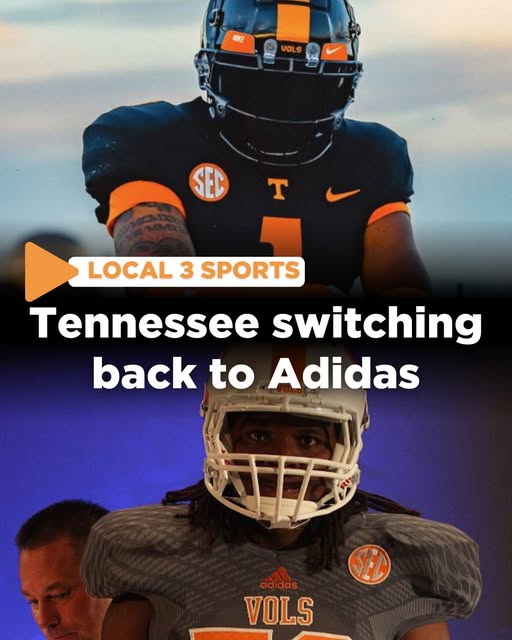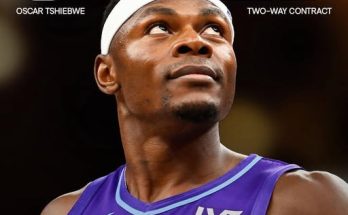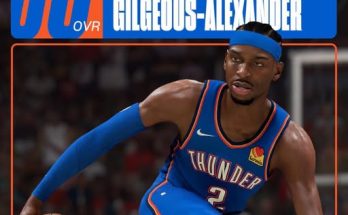BREAKING NEWS: Tennessee to Return to Adidas, According to Sports Director Ben Bobick
The University of Tennessee Volunteers are preparing to rekindle their storied partnership with Adidas—bringing the iconic three stripes back to Neyland Stadium for the first time since 2015, according to confirmation from Sports Director Ben Bobick. The announcement marks a watershed moment for Rocky Top, where tradition, finances, NIL imperatives, and fan sentiment collide in a dramatic clash over orange, stripes, and brand identity.
After more than a decade under Nike’s banner, the Volunteers are poised to bring Adidas back, beginning in 2026 when their existing contract with Nike expires. The decision—validated by reports from trusted sources such as Sports Business Journal—signals a deliberate pivot in strategy by Tennessee’s athletic department, which has weighed tradition, revenue, and modern collegiate athletics pressures .
Under the current arrangement, Tennessee has worn Nike since a celebrated switch in 2015, following a long Adidas run from 1995–2014. That line was drawn sharply in part due to Adidas’s notorious struggles to nail the Volunteers’ signature orange—a sore point for fans who often described uniforms as “yellow” or mismatched . Nike streamlined the palette and design consistency beginning with that 2015 deal, which was extended through the 2025–26 season . Now, however, Adidas has not only returned to the negotiation table but evidently seized the lead.
Central to Adidas’s strategy is an aggressive bid: promising to double Tennessee’s apparel revenue, offering well above the $5–5.5 million annually they currently receive from Nike . That figure, confirmed by Rocky Top sources and Adidas’s proposal intel, underscores a high-stakes game in which Adidas is staking serious capital to woo Tennessee back into its fold.
The potential return to Adidas goes well beyond the mere uniform. Adidas is betting on athlete-forward incentives tied to NIL deals, aiming to empower Tennessee’s student-athletes with brand leverage, performance bonuses, and marketing support that goes deeper than what traditional apparel contracts allow. That approach, now a hallmark of modern sports marketing, fits within the evolving NCAA landscape—where athletes can monetize their name, image, and likeness, and apparel brands can tap into that dynamic.
In recent years, Nike has aggressively invested in NIL-friendly deals itself—such as Ohio State, Texas, and Oregon—some netting as high as $16–17 million annually for those schools Tennessee’s administrators have clearly taken notice. By sidestepping Nike’s first right to match (the voluntary deadline passed in December 2024), Tennessee left the door open for Adidas to make its move—suggesting a strategic and intentional shift, rather than an impulsive one .
Despite the financial appeal, the reaction among the fan base has been electric. Vol Twitter erupted with nostalgia, outrage, wounded pride, and caution. Loyalists to the Nike era—many of whom found solace in the brand’s consistent color accuracy—have threatened to boycott Adidas gear. One fan tweeted, “I am absolutely disgusted. I will not buy adidas. Nike is miles ahead…” Another declared flatly: “I won’t touch any merchandise for however long this would last” . Even uniform historians rehashed painful visuals: “Some of y’all have forgotten the mismatched, yellow… slop adidas put the Vols in” These fan voices express a visceral rejection of past Adidas failures, particularly around color quality.
Yet others have countered that nostalgia should not outweigh dollars and strategic positioning. A voice from the sideline pointed out, “Whether folks like it or not, in the days of NIL, the best deal wins” . Indeed, Adidas is presenting a compelling case: modern athletes are looking for partnership flexibility and revenue potential that go beyond fixed product allotments.
If finalized, the deal would represent Tennessee’s most lucrative apparel partnership yet. Adidas is expected to offer north of $10 million per year—including base pay, performance bonuses, and substantial NIL revenue-sharing—potentially even brushing the billion-dollar mark across its term. Moreover, the package reportedly includes research labs, community engagement initiatives, and design innovation hubs based at Tennessee—an ecosystem designed to elevate both the brand and the university .
Adidas is also promising to fix what fans have long despised: the orange. The new contract reportedly mandates tighter quality controls, upgraded color management protocols, and centralized oversight to avoid the calibration missteps of the past. Breaking away from traditional product contracts, Adidas could institute an aesthetic task force to ensure uniform consistency—a far cry from the era of clashing pant and helmet hues.
This potential Adidas resurgence comes at a pivotal moment in college athletics. The NCAA’s adoption of NIL rules in 2021 shifted recruiting dynamics dramatically. Athletes now seek programs offering not just coaching and exposure, but strategic brand partnerships that amplify their personal value. For Tennessee—a program searching for relevance and competitiveness in the SEC—the Adidas return positions the Volunteers at the front of a recruiting class interested in structured marketing support and brand visibility.
To be sure, the deal is not fully signed yet. Nike retains a contractual right to match Adidas’s offer. If Nike chooses to compete, Tennessee could remain with the swoosh. If Adidas wins, Tennessee’s transition will likely commence in early 2026—giving ample time for new uniforms, launch campaigns, and retail strategy implementation well before the 2026 football season .
Rocky Top insiders and Tennessee’s athletic department can quietly strategize—if they follow through, 2026 will begin with a full brand reawakening: stripes, design labs, athlete endorsements, and NIL-centered initiatives all rolled into one comprehensive package.
On the flip side, this shift risks alienating a large portion of the fan base. Merchandise sales may slump if nostalgia-driven boycotts gain traction. Adidas carries baggage—past critique around labor practices, uniform quality, and misalignment with Tennessee’s aesthetic heritage . Public relations missteps could overshadow contract benefits, especially if early uniforms still fail to consistently capture the beloved shade of Tennessee orange.
This scenario places Nike in an interesting spot as observer or competitor. Recently, Nike solidified its dominance by renewing landmark deals with both the NBA and WNBA through 2037—an indicator of its continued market strength . Its model of integrated branding, product innovation, and athlete preference has proven powerful. If Nike decides the prize of Tennessee is worth fighting for, their counteroffer could match or exceed Adidas, offering yet another battle in the apparel arms race.
Yet even if Nike bows out, one would be hard‑pressed to deem the Adidas deal a purely sentimental pivot. As Ben Bobick notes, this strategy appears multi-dimensional: nostalgic legacy, enhanced athlete support, and a financially “best in class” plan for the foreseeable future. It’s a multifaceted move, not just a logo swap—one signaling that Tennessee is playing to win both on and off the field.
As tee shirt production and stadium branding prepare to pivot, the narrative also shifts: apparel companies are no longer silent partners—they’re frontline participants in NAME/IMAGE/LIKENESS and revenue creation. Tennessee’s potential return to Adidas isn’t a simple refresh—it’s a statement, a strategy, and a bet on the future direction of collegiate athletics.
In Nashville, Knoxville, and far beyond, the debate rages: will fans embrace stripes and structure, or cling to the swoosh and streamlined identity? Will recruits be wooed by athlete‑centric innovation labs and NIL outreach? Or sweat the shade of orange?
The next few months should tell the full story. The Kentucky platform of college sports media, combined with deep analytics and social sentiment monitoring, will force Tennessee’s athletic department to carefully calibrate rollout plans—rolling out retro collections, color prototypes, and athlete-focused endorsements that prove Adidas has indeed earned its stripes.
Should Adidas follow through and nail design execution, NIL support, and financial leadership, Tennessee’s pivot could become a model for how legacy programs evolve in the college sports marketplace. But if color consistency falters again, or public backlash escalates, the move may become one of the most regrettable missteps in recent apparel history.
Either way, Rocky Top will be watching. The bright lights, booming chants, and sea of orange that define Tennessee football will soon play out under either swooshes or stripes. Come 2026, the Volunteers won’t just be changing uniforms—they could be changing the rules of college sports branding in real time.
Until then, all eyes remain on Adidas, Nike, and Tennessee—on a decision that’s far more than fashion, far heavier than weave, and infinitely bigger than uniforms.



